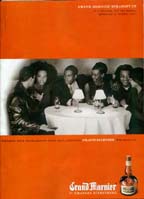| |
 |
|
The purpose of [ads] is to make the spectator
marginally dissatisfied with his (sic) present way of life.
Not with the way of life of society, but with his own within
it. It suggests that if he buys what it is offering, his life
will become better. It offers him an improved alternative
to what he is...All publicity works upon anxiety. Alternatively
the anxiety on which publicity plays is the fear that having
nothing you will be nothing. (Berger 142-3)
|

|
Ads also work by appealing to anxieties
in consumers. Supposedly, buying the products will make us feel better.
Have you ever gone shopping because you're depressed or upset?
|
Advertising deals in open sores....Fear. Greed. Anger. Hostility.
You name the dwarfs and we play on every one. We play on all the
emotions and on all the problems, from not getting ahead...to
the desire to be one of the crowd. Everyone has a button. If enough
people have the same button, you have a successful ad and a successful
product.
Advertising executive Jerry Della Femina 1981, quoted
by William Meyers
|
What are your buttons?
Lots of people, especially women, are buying cell phones to soothe their
anxieties about commuting. Click here to view a very effective cell
phone commercial.
View the commercial again with and without sound using the Principles
of Media Literacy and the Six Questions
on Media from the Understanding Stereotypes unit.
What can we learn from the video about the nature of our culture and
the relations between men and women?
 
Psychogenic profiles are used by advertising companies
to target audiences for their products. Brand names and the attitudes
associated with them are more important than product quality. Through
market research, advertisers hope to identify people's emotional vulnerabilities
and make commodities seem "part of the soothing solution" to
their "weaknesses and deep-seated emotional needs." (Meyers,
6-7)
In his book The Image Makers: Power and Persuasion on Madison Avenue,
William Meyers says:
| At the heart of Madison Avenue's new, elaborately engineered system
of persuasion lies one fundamental premise: Each group in our society
has its weakness and deep-seated emotional needs. If Ad Alley can
uncover these psychological problems in the course of its lengthy
interview with citizens and then devise 30-second television spots
that make it seem as if ordinary, everyday products are part of
the soothing solution, grateful and relieved consumers will purchase
the advertised goods. Agencies can make big profits by isolating
and identifying each population segment's vulnerabilities, transforming
average run-of-the-mill items into magic panaceas, and then targeting
their newly designed therapeutic sales pitches at the right cluster
of people. (6-7) |
AC assignment 1: Study the above quote and write a paraphrase
of it. Review the articles on psychographics by Meyers and Campbell.
Write a brief summary of the argument presented.
SRI is the famous consultant company mentioned by Meyers and Campbell.

Here is one way they pitch their services:
SRI Consulting's VALS Program is based on the basic
forces driving consumer choices and three fundamental beliefs
about consumer segmentation: A psychographic segmentation system
is effective as a marketing tool because it represents the 'fundamentals'
of the marketplace-- i. e., attributes of consumers that are
both powerful predictors and broadly applicable. Demographics
alone are practically and conceptually insufficient to model
consumer behavior, especially as the subjective elements of
image and positioning become decisive in product choice. Psychographics
are powerful because they reveal the key attitudes that motivate
behavior.
 SRI
Consulting Industry Practices and Services SRI
Consulting Industry Practices and Services
|
AC assignment 2: Study the
eight categories SRI divides people up into and
link to their consumer survey.
 
 |
| VALS (Values and Lifestyles) categorizes U.S. adult consumers
into mutually exclusive groups based on their psychology
and several key demographics. VALS is unique because it
highlights factors that motivate consumer buying behavior.
Other segmentation systems, based solely on demographics
or geographics, cannot do this because they do not look
at the underlying psychological make-up of people. Companies
that know why their customers act the way they do have a
competitive edge. |
|
Let's use William Meyers five categories
from The Image Makers to analyze the target audiences of ads.
| Belongers |
conservative, like traditional lifestyles, old-fashioned approaches
to patriotism, religion and family. "Without a secure, stable,
and structured society, this staunch defender of the status quo
is unable to cope." (Meyers 16)
|
| Emulators |
hedonistic, confused, insecure, have desire to know future will
be profitable and prosperous. "Small but impressionable group
of young people in desperate search of an identity and a place in
the adult working world." (16)
|
| Emulator-Achievers |
successful and conspicuous consumers who want even more, have expensive
tastes, and buy symbols of prestige to appease their worry. "Once
they believed the sky was the limit" but now they are "dissatisfied
with the quality of their lives." (18)
|
| Societally Conscious
Achievers |
individualistic, don't like conspicuous consumption, nonmaterialistic,
like nature, fitness, simplicity. "Baby boom generation who
care more about inner peace and environmental safety than about
financial success and elegant surroundings." (19)
|
| Need-directed survivors: |
people struggling to sustain themselves on subsistence incomes."
(20) Considered "dirt poor losers," ad execs don't really
think of them as consuming much since they too busy just trying
to stay afloat.
|
AC assignment 3: Click
on the picture below to see sample ads to categorize.


|
|


![]()